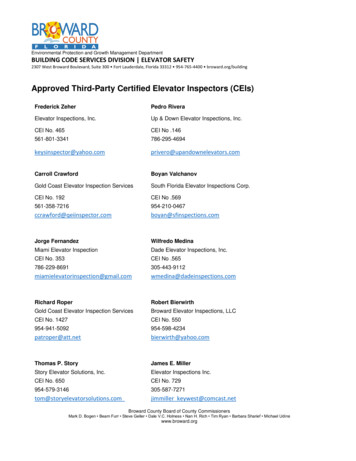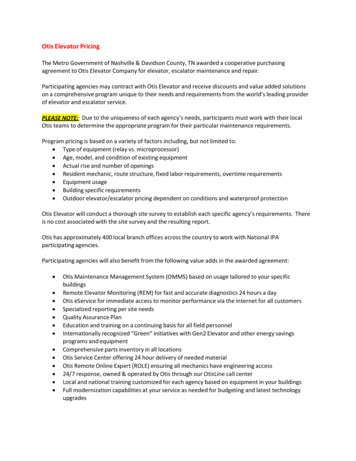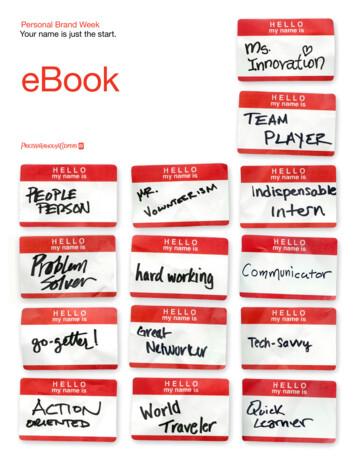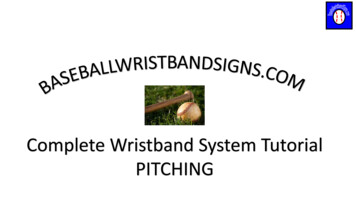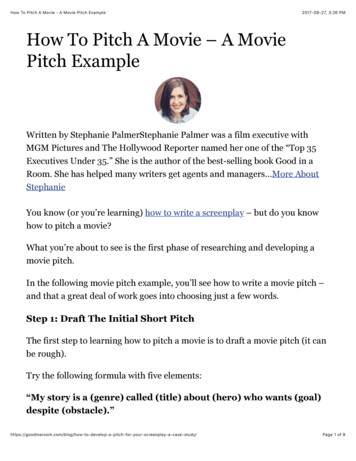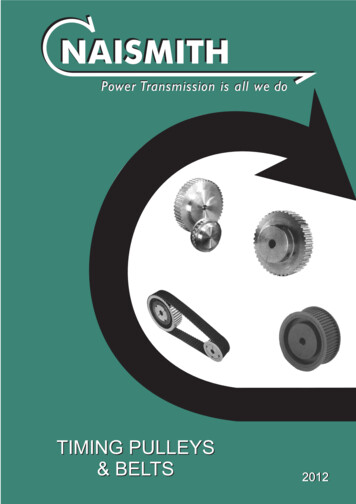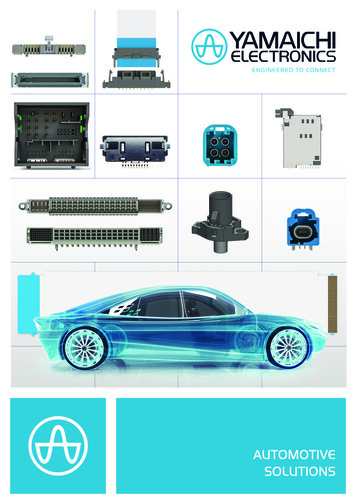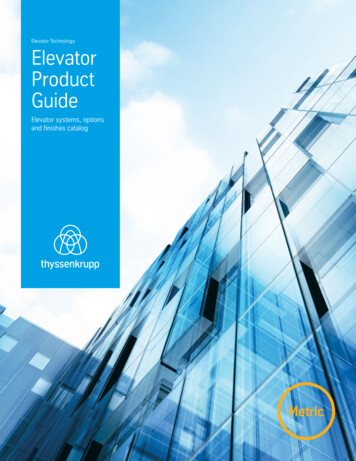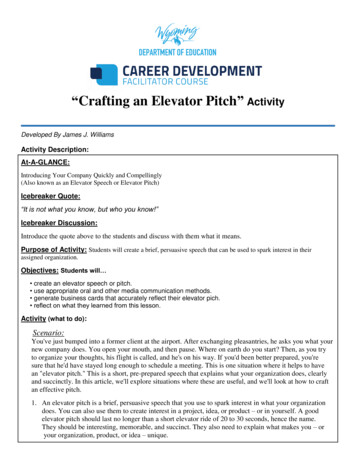
Transcription
“Crafting an Elevator Pitch” ActivityDeveloped By James J. WilliamsActivity Description:At-A-GLANCE:Introducing Your Company Quickly and Compellingly(Also known as an Elevator Speech or Elevator Pitch)Icebreaker Quote:“It is not what you know, but who you know!”Icebreaker Discussion:Introduce the quote above to the students and discuss with them what it means.Purpose of Activity: Students will create a brief, persuasive speech that can be used to spark interest in theirassigned organization.Objectives: Students will create an elevator speech or pitch. use appropriate oral and other media communication methods. generate business cards that accurately reflect their elevator pich. reflect on what they learned from this lesson.Activity (what to do):Scenario:You've just bumped into a former client at the airport. After exchanging pleasantries, he asks you what yournew company does. You open your mouth, and then pause. Where on earth do you start? Then, as you tryto organize your thoughts, his flight is called, and he's on his way. If you'd been better prepared, you'resure that he'd have stayed long enough to schedule a meeting. This is one situation where it helps to havean "elevator pitch." This is a short, pre-prepared speech that explains what your organization does, clearlyand succinctly. In this article, we'll explore situations where these are useful, and we'll look at how to craftan effective pitch.1. An elevator pitch is a brief, persuasive speech that you use to spark interest in what your organizationdoes. You can also use them to create interest in a project, idea, or product – or in yourself. A goodelevator pitch should last no longer than a short elevator ride of 20 to 30 seconds, hence the name.They should be interesting, memorable, and succinct. They also need to explain what makes you – oryour organization, product, or idea – unique.
2. When to use an Elevator Pitch.Some people think that this kind of thing is only useful for salespeople who need to pitch their productsand services. But you can also use them in other situations. For example, you can use one to introduceyour organization to potential clients or customers. You could use them in your organization to sella new idea to your CEO, or to tell people about the change initiative that you're leading. You can evencraft one to tell people what you do for a living.3. Past out the “Creating an Elevator Pitch” handout. Review the handout.4. Keep in mind that your pitch should excite you first; after all, if you don't get excited about what you're saying,neither will your audience. Your pitch should bring a smile to your face and quicken your heartbeat. People maynot remember everything that you say, but they will likely remember your enthusiasm.Tip 1: You may want to keep small take-away items with you, which you can give to people after you'vedelivered your pitch. For example, these could be business cards or brochures that talk about yourproduct idea or business.Tip 2: Remember to tailor your pitch for different audiences, if appropriate. That's much moreinteresting, and shows the value that you provide to these organizations.5. Students will use computers to create a sheet of business cards that captures the essence of their pitchand organization.Extensions:Key PointsAn elevator pitch is a brief, persuasive speech that you can use to spark interest in what your organizationdoes. You can also use one to create interest in a project, idea, or product. It needs to be succinct, whileconveying important information.To craft a great pitch, follow these steps. Identify your goal. Explain what you do. Communicate your USP. Engage with a question. Put it all together. Practice.Try to keep a business card or other take-away item with you, which helps the other person remember youand your message. And cut out any information that doesn't absolutely need to be there.it?Reflection Questions:1. Find a friend or adult within your network to practice your elevator speech with and to help you refineyour speech.2. What did you learn about yourself during this exercise?3. How could you use this activity to create an affective business card?Evaluation of Learning: Have students try their pitch on other members of the class, other teachers in the building, or familymembers. Have students turn in their pitch and a reflection of how their pitch went when they tried it on otherpeople. Have students turn in a copy of their business card.Students will be evaluated on the quality of their pitch, their written reflection, and the accuracy oftheir business card in terms of their pitch.
Duration/Length:Two 45-50 minute class periods or one 90 minute block period.Tools/Materials Needed:Ethical Behavior Worksheet (1 per student)PencilButcher Paper (White, Yellow, or any light color that is easy to read from a distant) per group and one masterfor each classSet of Markers per groupPartnerships Recommended:CDFClassroom Teacher, Counselor, or other educational professionalSpecial Ed parasDevelopmental Level (e.g. Preschool, Elementary, Middle, College, etc.):Adaptable for Elementary, Middle School, High School, and College.Suggestions for Scaling (ideas for use with students of other ages):Number of and type of questions asked.Length of time.For lower grade levels provide actual graphic organizers.For lower grade levels provide more guided practice and direction.When done within semester of school year.Advancing skill over time (activity that transcend entire school year allowing for increased complexity).Have students keep this activity handy to remind them of their visualized goal and make modifications asthings change.Standards Covered (NCDA Guidelines, WY C/VE Standards, ASCA Mindsets & Behaviors):K-5:Standard 1 Career Development and Readiness.CV5.1.4: Students complete task within an allotted time by acquiring, storing, organizing, and using materialsand space efficiently.Standard 2 Communication and Collaboration.CV5.2.2 Students share new concepts learned through peer teaching and presenting to a group.Standard 3 Critical Thinking and Problem Solving.CV5.3.4 Students seek help from appropriate people (staff, students, parents, etc.) and appropriate resources.Standard 4 Technical Literacy.CV5.4.1 Students use a variety of methods including oral, written, graphic, pictorial, and/or multimedia in orderto create and share a product.
6-8:Standard 1 Career Development and Readiness.CV8.1.1 Career aware students explore several career pathways including but not limited to outlook, salary,needed training, duties, and lifestyle.CV8.1.3 Career aware students prepare a self improvement plan including secondary and postsecondaryprograms to gain desired knowledge and experience toward possible career opportunities.Standard 2 Communication and Collaboration.CV8.2.1 Career aware students effectively communicate using a variety of appropriate methods.Standard 3 Critical Thinking and Problem Solving.CV8.3.4 Career aware students plan, manage and complete projects in a timely and effective manner.Standard 4 Technical Literacy.CV8.4.4 Career aware students integrate and translate content presented in diverse formats and media,including visually and in words.9-12:Standard 1 Career Development and Readiness.CV12.1.1 College and career ready students evaluate current knowledge and interests in order to set careergoals.CV12.1.3 College and career ready students prepare an educational and career plan to enable them to gaindesired knowledge and experience.CV12.1.4 College and career ready students demonstrate employability skills that enable them to beresponsible and contributing citizens and employment.Standard 2 Communication and Collaboration.CV12. 2.1 College and career ready students communicate clearly, effectively, and with reason.Standard 3 Critical Thinking and Problem Solving.CV12. 3.4 College and career ready students demonstrate creativity and innovation while considering theenvironmental, social, and economic impact of decisions.References/Developed By: FM6-22 Leader Development US Army Manual FM 22-100 Army Leadership; Be Know, Do US Army Manual US Army Values and Code of Ethics Jim Rohn, Motivational Speaker Website Source: www.GoodCharacter.com FOCUS (36 10 Minute Lesson Plans) By Phil Boyte, Micah Jacobson, & Ron Jones MN Program of Study Web Site Facilitating Career Development Third Edition by Barbara H. Suddarth & David M. Reile Designing and Implementing Career Services by National Career Development Association GAcollege411 xpand Your Opportunities @ www.gacollege411.org. University of Missouri Student Success Center MU Career Center Compare and Contrast images at Google Images 2014 Wyoming Career & Vocational Education Content Performance Standards by Wyoming State Board ofEducation Mindtools; itch.htm
Creating an Elevator PitchIt can take some time to get your pitch right. You'll likely go through several versions before finding one that iscompelling, and that sounds natural in conversation.Follow these steps to create a great pitch, but bear in mind that you'll need to vary your approach depending onwhat your pitch is about.1. Identify Your GoalStart by thinking about the objective of your pitch.For instance, do you want to tell potential clients about your organization? Do you have a great new productidea that you want to pitch to an executive? Or do you want a simple and engaging speech to explain what youdo for a living?2. Explain What You DoStart your pitch by describing what your organization does. Focus on the problems that you solve and how youhelp people. If you can, add information or a statistic that shows the value in what you do.Example:Imagine that you're creating an elevator pitch that describes what your company does. You plan to use it atnetworking events. You could say, "My company writes mobile device applications for other businesses." Butthat's not very memorable!A better explanation would be, "My company develops mobile applications that businesses use to train theirstaff remotely. This results in a big increase in efficiency for an organization's managers."That's much more interesting, and shows the value that you provide to these organizations.3. Communicate Your USPYour elevator pitch also needs to communicate your unique selling proposition , or USP.Identify what makes you, your organization, or your idea, unique. You'll want to communicate your USP afteryou've talked about what you do.Example:To highlight what makes your company unique, you could say, "We use a novel approach because unlike mostother developers, we visit each organization to find out exactly what people need. Although this takes a bit moretime, it means that on average, 95 percent of our clients are happy with the first beta version of their app."4. Engage With a QuestionAfter you communicate your USP, you need to engage your audience. To do this, prepare open-ended questions(questions that can't be answered with a "yes" or "no" answer) to involve them in the conversation.Make sure that you're able to answer any questions that he or she may have.Example:You might ask "So, how does your organization handle the training of new people?"
5. Put it all TogetherWhen you've completed each section of your pitch, put it all together.Then, read it aloud and use a stopwatch to time how long it takes. It should be no longer than 20-30 seconds.Otherwise you risk losing the person's interest, or monopolizing the conversation.Then, try to cut out anything doesn't absolutely need to be there. Remember, your pitch needs to be snappy andcompelling, so the shorter it is, the better!Example:Here's how your pitch could come together:"My company develops mobile applications that businesses use to train their staff remotely. This means thatsenior managers can spend time on other important tasks."Unlike other similar companies, we visit each organization to find out exactly what people need. This meansthat, on average, 95 percent of our clients are happy with the first version of their app."So, how does your organization handle the training of new people?"6. PracticeLike anything else, practice makes perfect. Remember, how you say it is just as important as what you say. Ifyou don't practice, it's likely that you'll talk too fast, sound unnatural, or forget important elements of your pitch.Set a goal to practice your pitch regularly. The more you practice, the more natural your pitch will become. Youwant it to sound like a smooth conversation, not an aggressive sales pitch.Make sure that you're aware of your body language as you talk, which conveys just as much information tothe listener as your words do. Practice in front of a mirror or, better yet, in front of colleagues until the pitchfeels natural.As you get used to delivering your pitch, it's fine to vary it a little – the idea is that it doesn't sound tooformulaic or like it's pre-prepared, even though it is!
Standards Covered (NCDA Guidelines, WY C/VE Standards, ASCA Mindsets & Behaviors): K-5: . US Army Values and Code of Ethics Jim Rohn, Motivational Speaker Website Source: www.GoodCharacter.com FOCUS (36 10 Minute Lesson Plans) By Phil Boyte, Micah Jacobson, & Ron Jones

